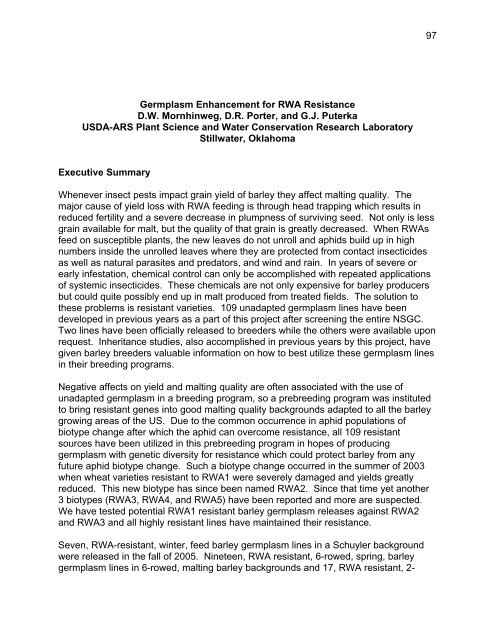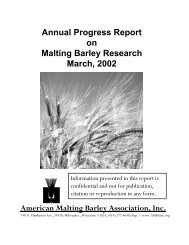Annual Progress Report on Malting Barley Research March, 2007
Annual Progress Report on Malting Barley Research March, 2007
Annual Progress Report on Malting Barley Research March, 2007
You also want an ePaper? Increase the reach of your titles
YUMPU automatically turns print PDFs into web optimized ePapers that Google loves.
Germplasm Enhancement for RWA Resistance<br />
D.W. Mornhinweg, D.R. Porter, and G.J. Puterka<br />
USDA-ARS Plant Science and Water C<strong>on</strong>servati<strong>on</strong> <strong>Research</strong> Laboratory<br />
Stillwater, Oklahoma<br />
Executive Summary<br />
Whenever insect pests impact grain yield of barley they affect malting quality. The<br />
major cause of yield loss with RWA feeding is through head trapping which results in<br />
reduced fertility and a severe decrease in plumpness of surviving seed. Not <strong>on</strong>ly is less<br />
grain available for malt, but the quality of that grain is greatly decreased. When RWAs<br />
feed <strong>on</strong> susceptible plants, the new leaves do not unroll and aphids build up in high<br />
numbers inside the unrolled leaves where they are protected from c<strong>on</strong>tact insecticides<br />
as well as natural parasites and predators, and wind and rain. In years of severe or<br />
early infestati<strong>on</strong>, chemical c<strong>on</strong>trol can <strong>on</strong>ly be accomplished with repeated applicati<strong>on</strong>s<br />
of systemic insecticides. These chemicals are not <strong>on</strong>ly expensive for barley producers<br />
but could quite possibly end up in malt produced from treated fields. The soluti<strong>on</strong> to<br />
these problems is resistant varieties. 109 unadapted germplasm lines have been<br />
developed in previous years as a part of this project after screening the entire NSGC.<br />
Two lines have been officially released to breeders while the others were available up<strong>on</strong><br />
request. Inheritance studies, also accomplished in previous years by this project, have<br />
given barley breeders valuable informati<strong>on</strong> <strong>on</strong> how to best utilize these germplasm lines<br />
in their breeding programs.<br />
Negative affects <strong>on</strong> yield and malting quality are often associated with the use of<br />
unadapted germplasm in a breeding program, so a prebreeding program was instituted<br />
to bring resistant genes into good malting quality backgrounds adapted to all the barley<br />
growing areas of the US. Due to the comm<strong>on</strong> occurrence in aphid populati<strong>on</strong>s of<br />
biotype change after which the aphid can overcome resistance, all 109 resistant<br />
sources have been utilized in this prebreeding program in hopes of producing<br />
germplasm with genetic diversity for resistance which could protect barley from any<br />
future aphid biotype change. Such a biotype change occurred in the summer of 2003<br />
when wheat varieties resistant to RWA1 were severely damaged and yields greatly<br />
reduced. This new biotype has since been named RWA2. Since that time yet another<br />
3 biotypes (RWA3, RWA4, and RWA5) have been reported and more are suspected.<br />
We have tested potential RWA1 resistant barley germplasm releases against RWA2<br />
and RWA3 and all highly resistant lines have maintained their resistance.<br />
Seven, RWA-resistant, winter, feed barley germplasm lines in a Schuyler background<br />
were released in the fall of 2005. Nineteen, RWA resistant, 6-rowed, spring, barley<br />
germplasm lines in 6-rowed, malting barley backgrounds and 17, RWA resistant, 2-<br />
97
















